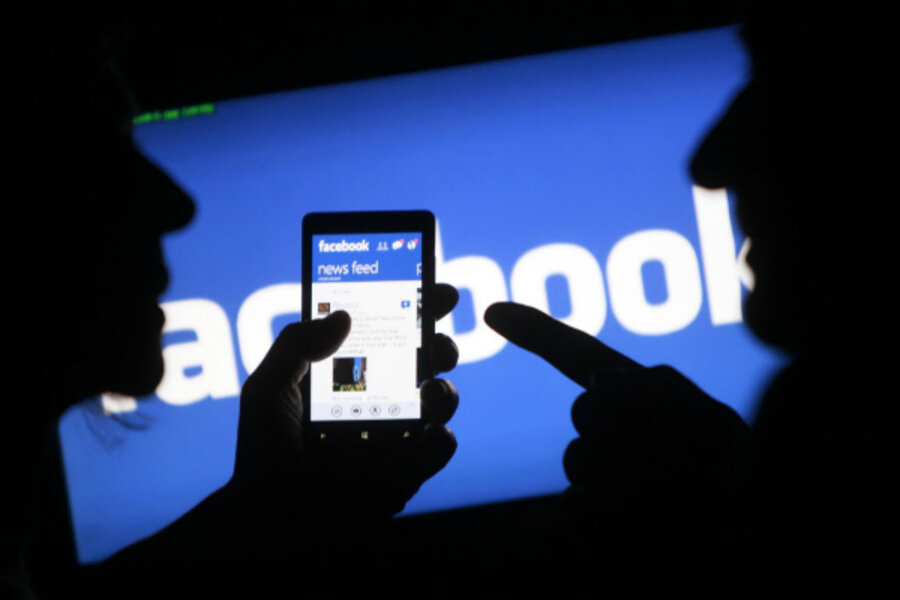Facebook cracks down on hate speech against women
Loading...
If Facebook were a city, these would be its seedy back alleys – user-generated groups filled with jokes about rape and domestic violence, captioned over gruesome images of assaulted women.
But after protesters sent some 60,000 tweets to advertisers making note such posts, Facebook this week announced that it is stepping up efforts to eliminate such gender-based hate speech from the site, apologizing that it had “failed to capture all the content that violates our standards.”
The announcement came on the heels of a week-long social media campaign by women's rights activists, organized around the hashtag #FBRape, which brought down a barrage of thousands of angry tweets and letters on Facebook and, especially, its advertisers.
Facebook is locked in near-constant fights over its content, ranging from users rallying against changes to the site’s layout to those demanding increased privacy settings and more protection of their data.
But what helped lift the #FBRape campaign above the fray of the standard social networking chatter, experts say, may have been the demographic that launched it: women.
Women are the muscle of the social media world, making up the majority of users on sites like Facebook, spending more time and creating more content than their male counterparts, according to Lee Rainie, director of the Pew Research Center’s Internet Project.
“We’re not a marginalized group on these sites,” says Soraya Chemaly, a writer and activist who was among the leading organizers of the campaign. “This isn’t some pet project special interest they’re supporting – it’s more than half their users.”
So far anyway, Facebook seems to have gotten the message. In a blog post Tuesday evening, the company announced that it would update its guidelines around hate speech, ensure its employees were accurately identifying prohibited content on the site, and take steps to prevent users from posting such content anonymously.
“When people have to use their real names, it enforces social norms,” says Gerald Kane, an associate professor of information systems at Boston College and an expert on social media. “You’re not going to misbehave as much if your friends are watching you.”
Organized by activist groups Women, Action, and the Media (WAM) and the Everyday Sexism Project, along with Ms. Chemaly, the #FBRape campaign began last week with a call for Facebook users to contact companies whose ads were appearing on pages beside the violent and misogynist content and call for them to withdraw their advertising from the site.
At issue were not just the violent images themselves, but also the fact that Facebook was failing to delete them when users flagged the photos as hate speech. In one screenshot posted to the WAM site, a user had reported an image of a woman shot in the head with the caption, “I like her for her brains.” Below it, an automated response from the site read, “We reviewed the photo you reported, but found it doesn’t violate Facebook’s Community Standard.”
Over the next week, activists sent out more than 5,000 e-mails and more than 60,000 tweets to advertisers, according to WAM, prompting more than a dozen companies – including Nissan – to pull ads from Facebook.
Facebook, meanwhile, responded almost immediately to the campaign, says Jaclyn Friedman, executive director of WAM. She says the protest's organizers were in touch with the company by Thursday of last week, and had begun discussing how the company could improve its policies.
Facebook, after all, has a reason to be responsive in this case, Ms. Friedman says. “We’re the reason these sites exist, the people on whose data these companies make money. And women increasingly aren’t accepting their treatment in these spaces.”
A study released in April by the Pew Internet Project found that, of all Internet users, 71 percent of women used social networking sites, compared with just 62 percent of men. Female social media users in North America spend an average of 12 hours on social media each week, according to a separate study by the global communications firm Weber Shandwick.
So there’s good reason to take their interests under account, Mr. Kane says. At the same time, Facebook doesn’t want to police the boundaries of good taste, and anyway, a site with a user base of 1 billion can do only so much to ward off bad apples.
“They don’t want to be purveyors of hate,” he says, “but a certain segment of the population will probably always be ugly.”








